
AMD 2200+ XP and MSI KT3 Ultra2
Written by John Yan on 11/12/2002 for
PC
More On:
AMD 2200+ XP and MSI KT3 Ultra2
I’ve been holding off on upgrading my computer for a while now partly because technology changes so fast nowadays that it’s hard to know when to jump in and be happy with what you have before it becomes second fiddle a month later. Well as it happens, I decided to hop on to the Thoroughbred and AMD releases the XP 2400+ and XP 2600+ with some overclocking ability that wasn’t present in the XP 2200+. Not much time was given for the XP 2200+ to reign supreme as the fight between Intel and AMD for the best CPUs continue to produce faster chips at a quick pace. Such is the life of computers. No matter how fast yours is it’ll be old news in a matter of months.
Well today I look at a combo that’s nicely priced and will get you some performance that’s nothing to sneeze at. For the CPU I decided to pick up an AMD XP 2200+ and for the motherboard the MSI KT3 Ultra2. The AMD XP 2200+ was purchased at TCWO for $145 at the time of this writing. It’s the OEM version with no heatsink so you’ll have to pick up a heatsink of your choice to cool this puppy off. Since TCWO gives you a 1-year warranty with a purchase of a heatsink/fan, I decided to also pick up the Coolermaster Pure Copper HCC-002 HSF for $25. Without a heatsink/fan purchase, the CPU only has a 20-day warranty. The motherboard was picked up from NewEgg for $85 at the time of writing. NewEgg has a good rating on Reseller Ratings but TCWO has a lower rating than I think it deserves. I’ve used TCWO for a few years now and have no problems whatsoever. Even recently when I ordered the AMD XP 1600+ and wanted to change my order that day to the 2200+, the customer service representative was very helpful in changing my order and providing times and an extension to call him back to make sure the order change was processed. If you’re looking for good service and great prices, check both of them out. NewEgg has always been great to me also and that's one store I would also highly recommend to anyone in need of great price and service.Total cost for the motherboard and CPU with heatsink upgrade with shipping was ~$245.
So let’s start off with the AMD XP 2200+. The true clock speed of the 2200+ is 1.8GHz. As you probably know by now, AMD changed their marketing of their chips to reflect how the performance relates to Intel’s chips. The chip is manufactured at a 0.13-micron process, which is a die-shrink from their previous chips. The smaller die means cooler performance and less voltage needed to run the CPU. The Socket A processor front side bus speed is still at 266MHz and the voltage needed to make the processor hum is 1.65V. In comparison, my Duron 1.2GHz needed 1.76V to work. So I have a faster processor that should run cooler and utilizing less power with AMD’s move to the smaller die size. I’d make sure to check with your board manufacturer to see if it is compatible and sometimes it just needs a BIOS update to get it to work.

Let’s move onto the motherboard. This is my first MSI board having used Tyan, ASUS, and ABIT for most of my past upgrades. I’ve seen many good reviews on the MSI board so I decided too take the plunge. I was looking for a good motherboard with USB 2.0 support and the KT3 Ultra2 has that and much more. For starters, the board sports the VIA KT333 chipset for the northbridge and the VIA VT8235 chipset for the southbridge. The VT8235 has integrated Direct Sound AC97 audio, dual channel Ultra DMA 33/66/100/133 master mode EIDE controller, ACPI, and integrated USB 2.0 controller. There are three memory slots supporting 184-pin DDR DIMMs and with each holding a maximum of 1GB of ram for a maximum total of 3GB of ram. For expansion slots, there are five PCI slots, one AGP slot, and one Communication Network riser slot. Two IDE connectors give you up to four IDE device connections. For those who want to use Bluetooth, the KT3 Ultra2 offers an onboard Bluetooth connector that can be used by purchasing the Bluetooth module. USB 2.0 has a data rate of 480Mb/s compared to USB 1.1’s data rate of 12Mb/s and it’s backward compatible. The package includes a USB2.0 bracket that installs into one of the case slots and connects to the onboard connector. The bracket also has four LEDs that help diagnose problems with your computer. The combination of LEDs will let you know the status of your computer giving you an easy view of any problems that are occurring. Of course you’ll need easy access to the back of your computer to see this so maybe MSI should produce an indicator that fits on the front of the computer instead. The onboard sound offers 2, 4, or 6 channel sound and with the optional sound bracket you can also connect the computer to a receiver via an optical SPDIF jack.
 I must say MSI did a great job in laying out the board. I’ve had a few where cables or resistors get in the way making it hard for installation. For starters, the ATX power connector is situated between the PS/2 connectors and the CPU socket. Being up top and towards the back when mounted in a mid-tower case, it was easy for the wires from the power supply to attach to the motherboard without getting in the way of other components. Depending on your case, you might still be able to access the RAM slots that are positioned to the right of the CPU socket. I filled the two right most slots so that third inner slot was open and I found that I could put another DDR Ram if need be without too much hassle. The IDE connectors support Ultra DMA 33/66/100/133 so you got a nice range of hard drive access modes there. Four power fan connectors are arranged the board and placed logically. The CPU fan is in close proximity to the CPU socket for easy fan connection. If you get the optional northbridge fan, a connector is provided for you to connect to it. You can also attach a two additional fans but I chose to utilize converters to run all my fans through the large connectors from the power supply rather than draw any more power from the motherboard. All the front panel connectors are placed on the bottom right of the board and the instructions provide a nice clear and concise labeling of each one. I only had to connect all of my components once and the system ran fine with all the LEDs and switches working flawlessly. If you want to connect the onboard audio to front panels, connectors are also provided but certain pins must be jumpered if you don’t want to use them and rather have the sound output from the rear connectors. Again, MSI’s instructions were very clearly labeled on what each pin did. There are two onboard USB 2.0 pin headers so that you can have up to six USB ports. The two pin headers provide four more connectors in addition to the two rear connectors. All in all, the board is spaced out very nicely so that the various connectors are not jammed together in small spaces.
I must say MSI did a great job in laying out the board. I’ve had a few where cables or resistors get in the way making it hard for installation. For starters, the ATX power connector is situated between the PS/2 connectors and the CPU socket. Being up top and towards the back when mounted in a mid-tower case, it was easy for the wires from the power supply to attach to the motherboard without getting in the way of other components. Depending on your case, you might still be able to access the RAM slots that are positioned to the right of the CPU socket. I filled the two right most slots so that third inner slot was open and I found that I could put another DDR Ram if need be without too much hassle. The IDE connectors support Ultra DMA 33/66/100/133 so you got a nice range of hard drive access modes there. Four power fan connectors are arranged the board and placed logically. The CPU fan is in close proximity to the CPU socket for easy fan connection. If you get the optional northbridge fan, a connector is provided for you to connect to it. You can also attach a two additional fans but I chose to utilize converters to run all my fans through the large connectors from the power supply rather than draw any more power from the motherboard. All the front panel connectors are placed on the bottom right of the board and the instructions provide a nice clear and concise labeling of each one. I only had to connect all of my components once and the system ran fine with all the LEDs and switches working flawlessly. If you want to connect the onboard audio to front panels, connectors are also provided but certain pins must be jumpered if you don’t want to use them and rather have the sound output from the rear connectors. Again, MSI’s instructions were very clearly labeled on what each pin did. There are two onboard USB 2.0 pin headers so that you can have up to six USB ports. The two pin headers provide four more connectors in addition to the two rear connectors. All in all, the board is spaced out very nicely so that the various connectors are not jammed together in small spaces.

A few cards are coming out that support AGP 8X but this board only goes up to 4X. It’s not too big a deal now but you might consider this when searching for a new board for future upgrades. Five PCI slots allow for good room for expansion.
The KT3 Ultra2 sports an AMIBIOS to control your motherboard settings. Like most boards these days, you can adjust the CPU preferences via the BIOS menu. In there you can change the CPU front side bus speed, multiplier, CPU voltage, DDR voltage, and AGP voltage. There’s enough here to do some damage to your components but for those who want to push their CPU to the limit, the options are there. As for the rest of the BIOS, the traditional changes and settings are there for you to play around with.
Thermal protection is included to try and protect your CPU. How it works is that when the thermal sensor senses an abnormal rise in temperature, it will shut down your system to protect your CPU. I can’t really say if this feature works well or at all since I only have one Athlon XP CPU to test with and I wasn’t about to fry it in case the feature doesn’t work. The manual states that it only works with Athlon XP CPUs, which leaves out some of the older AMD’s. Whether that’s true or not I could not test, but if it works as advertise, it will help save you some CPUs if you overclock or your heatsink/fan dies.
 MSI includes a nice set of software to use in conjunction with your motherboard. For those who use Motherboard Monitor, MSI has their own software to help you check the health of your system. Dubbed PC Alert III, it features a little more user-friendly display of various motherboard settings such as temperature, voltage settings, and fan speeds. For added temperature protection, you can tell PC Alert III to shut down your computer at a designated temperature. Fuzzy Logic 4 allows you change the front side bus and voltage to overclock your CPU in Windows. There’s even an option for the computer to gradually increase the FSB and when the CPU reboots, you can go back into the program and set the FSB to one step below the reboot setting with a touch of the button. Call it overclocking made simple by MSI. Live Bios/ Live Driver is a very nice tool that will go to MSI’s site and lets you download and install various drivers easily. You can keep your BIOS up to date simply with this tool. MSI also includes a DVD player with 5.1 channel support but my Pioneer DVD drive decided to die on me before I could test the software. MSI’s software set is pretty useful and will help you get the most out of your motherboard.
MSI includes a nice set of software to use in conjunction with your motherboard. For those who use Motherboard Monitor, MSI has their own software to help you check the health of your system. Dubbed PC Alert III, it features a little more user-friendly display of various motherboard settings such as temperature, voltage settings, and fan speeds. For added temperature protection, you can tell PC Alert III to shut down your computer at a designated temperature. Fuzzy Logic 4 allows you change the front side bus and voltage to overclock your CPU in Windows. There’s even an option for the computer to gradually increase the FSB and when the CPU reboots, you can go back into the program and set the FSB to one step below the reboot setting with a touch of the button. Call it overclocking made simple by MSI. Live Bios/ Live Driver is a very nice tool that will go to MSI’s site and lets you download and install various drivers easily. You can keep your BIOS up to date simply with this tool. MSI also includes a DVD player with 5.1 channel support but my Pioneer DVD drive decided to die on me before I could test the software. MSI’s software set is pretty useful and will help you get the most out of your motherboard.
So after taking out all my old components, I threw the new motherboard and chip into my case. The Coolermaster HSF that I picked up was one of the easiest ones I’ve ever installed. The clip to keep the heatsink on the CPU was incredibly easy to hook onto the motherboard. I had no problems attaching my various expansion cards and front LEDs and switches. I had two hard drives and a CD/RW with my two HDs going into IDE1 and my lone CD/RW into IDE2. The ATA/133 cable took a little fiddling to attach to the motherboard. I checked the pins and the connector and everything seemed ok but it just wouldn’t connect smoothly. After a good strong push, the cable was finally plugged into the IDE1 connector. I didn’t have the problem with the IDE2 connector and I couldn’t really tell what was giving me the resistance. In any case, the hard drives were recognized and worked flawlessly. All in all, it took me about forty-five minutes to an hour to get my system fully up and to the POST screen.
Here’s my final setup:
Athlon XP 2200+
MSI KT3 Ultra2
2 sticks of Crucial 256 PC2100 DDR RAM
Western Digital 80GIG 7200RPM HD
IBM Deskstar 40GIG 7200 HD
Plextor 12x10x32 CD/RW
ATi Radeon All-In-Wonder 8500 128MB
Hercules Game Theater XP
D-Link 10/100 Ethernet card
Running a clean install of Windows XP, I proceeded to give the CPU some good burn in time before I did some testing. For several weeks, the computer ran flawlessly and I didn’t experience any lockups, crashes, or restarts. That’s good to see as one of the things a good motherboard should be is stable and reliable. Earlier I mentioned the fact that the CPU’s smaller die size should enable it to run cooler, thus you can use a smaller and quieter fan to cool down your system. From MSI’s BIOS, I had a temperature load of around 42C, which are a few degrees cooler than my Duron, which ran at around 47C. The difference can be also contributed to the fact that I am using two different heat sink fan combinations in my Duron and Thoroughbred. My Duron has a Dragon Orb 3 attached to it, which isn’t a bad performer but it’s a tad under the Coolermaster HCC-002 one I have attached to the Thoroughbred. The new Thoroughbreds that were just released seem to be a lot more of what people were expecting in terms of temperature and overclocking.
In general, the few games I ran were smooth as silk. Madden 2003 with all the options turned on and running at 1024x768x32 looked incredible and really impressed me at how graphically beautiful and smooth it was. The computer had no trouble keeping the framerate high when many characters were interacting on screen from a naked eye perspective. Unreal Tournament also looked like a new game coming from a Duron 1.2 to an AMD XP 2200+. Movement was incredibly smooth at 1024x768 with all the options turned on. Even Unreal Tournament 2003 played extremely well from my perspective. But we’ll have some hard numbers on how fast it really ran a little later in the review as we throw up the benchmarks. With all the games I tried, I was pretty happy going from a Duron 1.2 to an AMD XP 2200+.
Now that I’ve had some time to play around with the computer and let the CPU have some running time, I threw the usual barrage of tests at it. To test this new setup I ran the following tests:
3DMark SE – MadOnion
Quake 3 – id Software
Unreal Tournament 2003 – Epic Games
Comanche 4 Demo – NovaLogic
Before I get into the tests, all of the benchmarks were done with the latest Catalyst driver release specifically suite 2.3. I also turned off all V-Sync and disabled sound from the demos. That way the CPU would not waste any cycles calculating sound.
3DMark SE – MadOnion
First off are the 3Dmark SE tests. Here’s what I got from the tests. All tests used compressed textures.
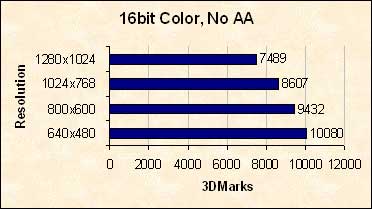
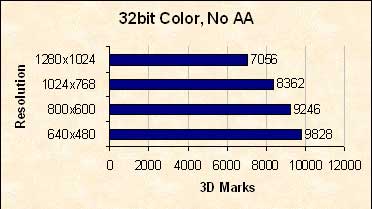
The next few had anti-aliasing turned on. As you can see, the video card takes a big hit with 4X AA activated.


Quake 3 – iD Software
Quake 3’s an oldie but still a goodie. Using q256’s batch run, I tested out 648x480 up to 1280x1024. I set the tests to run three times and the scores you see are an average of the three. What’s nice about the utility is that you can export it to Excel and have a very clean display of your results. Anyways, here are the scores:
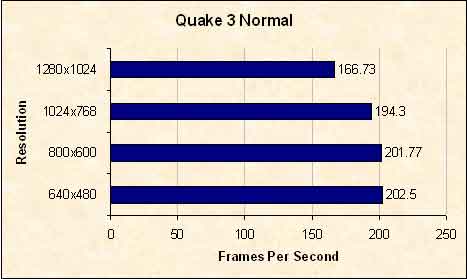
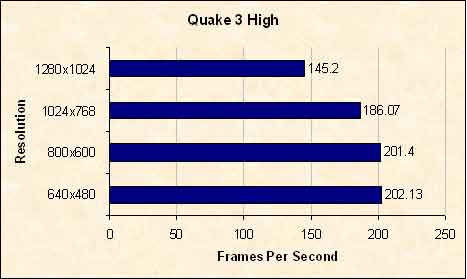
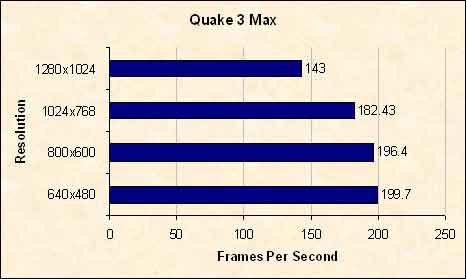
The scores here are nearly double of what I was getting with the Duron 1.2GHz chip. Using the same video card but changing the motherboard and upgrading the CPU gave me a very nice leap in performance.
Unreal Tournament 2003 – Epic Games
One of the newest benchmark games right now is Unreal Tournament 2003. I used [H]ardOCP’s great utility to do a batch run on three different resolutions. The utility sure made benchmarking easy and I highly recommend it to anyone wanting to see how UT2K3 runs on their system. The tests were only flybys as the botmatches took up CPU cycles so those were not used in testing the system. Here’s what we got for Unreal Tournament 2003.
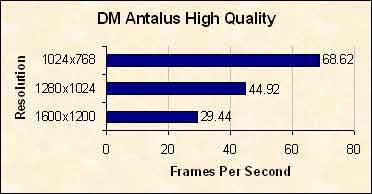
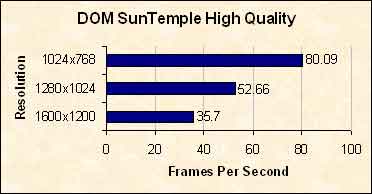
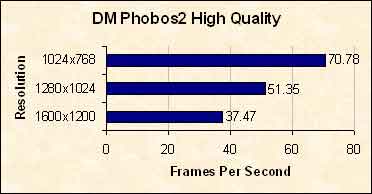
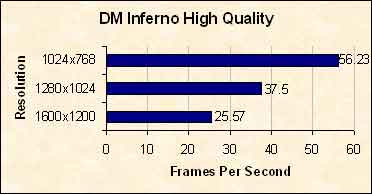
I didn’t have the game when the Duron was my main system so I can’t comment out how much of an increase there is. Running at close or above 60 frames per second at 1024x768 is pretty damn good and that’s more than plenty for smooth gameplay. The fps gets cut in half once it goes to 1600x1200. I’d like to see what the Radeon 9700 Pro would do though with this setup on that resolution and I hope to get one to test soon.
Comanche 4 Demo
This is the first time I’ve used the demo and to be honest I really like what it shows. The scenes it generates are pretty cool and it’s nice to have a different genre other than a first person shooter to benchmark a video card. Novalogic provides a nice easy interface to run a benchmark and it outputs it to a text file along with the settings you chose. Shaders were turned on along with texture compression.
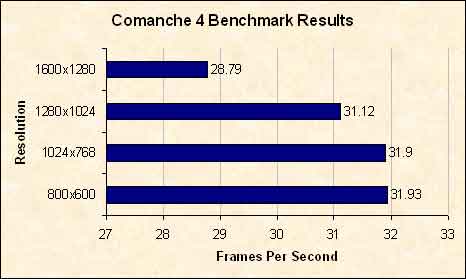
The entire setup set me back about $110 more than my old Duron and ECS K7S5A but it was definitely worth it. The CPU was a great performer even though it didn’t ran as cool as I thought it would. Even so, the thing screamed and provided incredible performance at a price you can’t beat. The MSI motherboard was more so impressive with its list of features and for a very moderate price of $85. The layout was clean and the red color PCB should look pretty cool for those with windows on their cases. My only complaint about the motherboard is that the LCD indicators were on a rear slot bracket instead of MSI producing a plate for the front of the computer. Other than that, the board was a solid stable performer with well-written instructions for those who put their own computer together. I’m very happy with the money I spent on this setup. The ease of installation and performance for the money I spent made me one very satisfy customer.

Well today I look at a combo that’s nicely priced and will get you some performance that’s nothing to sneeze at. For the CPU I decided to pick up an AMD XP 2200+ and for the motherboard the MSI KT3 Ultra2. The AMD XP 2200+ was purchased at TCWO for $145 at the time of this writing. It’s the OEM version with no heatsink so you’ll have to pick up a heatsink of your choice to cool this puppy off. Since TCWO gives you a 1-year warranty with a purchase of a heatsink/fan, I decided to also pick up the Coolermaster Pure Copper HCC-002 HSF for $25. Without a heatsink/fan purchase, the CPU only has a 20-day warranty. The motherboard was picked up from NewEgg for $85 at the time of writing. NewEgg has a good rating on Reseller Ratings but TCWO has a lower rating than I think it deserves. I’ve used TCWO for a few years now and have no problems whatsoever. Even recently when I ordered the AMD XP 1600+ and wanted to change my order that day to the 2200+, the customer service representative was very helpful in changing my order and providing times and an extension to call him back to make sure the order change was processed. If you’re looking for good service and great prices, check both of them out. NewEgg has always been great to me also and that's one store I would also highly recommend to anyone in need of great price and service.Total cost for the motherboard and CPU with heatsink upgrade with shipping was ~$245.
So let’s start off with the AMD XP 2200+. The true clock speed of the 2200+ is 1.8GHz. As you probably know by now, AMD changed their marketing of their chips to reflect how the performance relates to Intel’s chips. The chip is manufactured at a 0.13-micron process, which is a die-shrink from their previous chips. The smaller die means cooler performance and less voltage needed to run the CPU. The Socket A processor front side bus speed is still at 266MHz and the voltage needed to make the processor hum is 1.65V. In comparison, my Duron 1.2GHz needed 1.76V to work. So I have a faster processor that should run cooler and utilizing less power with AMD’s move to the smaller die size. I’d make sure to check with your board manufacturer to see if it is compatible and sometimes it just needs a BIOS update to get it to work.

Let’s move onto the motherboard. This is my first MSI board having used Tyan, ASUS, and ABIT for most of my past upgrades. I’ve seen many good reviews on the MSI board so I decided too take the plunge. I was looking for a good motherboard with USB 2.0 support and the KT3 Ultra2 has that and much more. For starters, the board sports the VIA KT333 chipset for the northbridge and the VIA VT8235 chipset for the southbridge. The VT8235 has integrated Direct Sound AC97 audio, dual channel Ultra DMA 33/66/100/133 master mode EIDE controller, ACPI, and integrated USB 2.0 controller. There are three memory slots supporting 184-pin DDR DIMMs and with each holding a maximum of 1GB of ram for a maximum total of 3GB of ram. For expansion slots, there are five PCI slots, one AGP slot, and one Communication Network riser slot. Two IDE connectors give you up to four IDE device connections. For those who want to use Bluetooth, the KT3 Ultra2 offers an onboard Bluetooth connector that can be used by purchasing the Bluetooth module. USB 2.0 has a data rate of 480Mb/s compared to USB 1.1’s data rate of 12Mb/s and it’s backward compatible. The package includes a USB2.0 bracket that installs into one of the case slots and connects to the onboard connector. The bracket also has four LEDs that help diagnose problems with your computer. The combination of LEDs will let you know the status of your computer giving you an easy view of any problems that are occurring. Of course you’ll need easy access to the back of your computer to see this so maybe MSI should produce an indicator that fits on the front of the computer instead. The onboard sound offers 2, 4, or 6 channel sound and with the optional sound bracket you can also connect the computer to a receiver via an optical SPDIF jack.


A few cards are coming out that support AGP 8X but this board only goes up to 4X. It’s not too big a deal now but you might consider this when searching for a new board for future upgrades. Five PCI slots allow for good room for expansion.
The KT3 Ultra2 sports an AMIBIOS to control your motherboard settings. Like most boards these days, you can adjust the CPU preferences via the BIOS menu. In there you can change the CPU front side bus speed, multiplier, CPU voltage, DDR voltage, and AGP voltage. There’s enough here to do some damage to your components but for those who want to push their CPU to the limit, the options are there. As for the rest of the BIOS, the traditional changes and settings are there for you to play around with.
Thermal protection is included to try and protect your CPU. How it works is that when the thermal sensor senses an abnormal rise in temperature, it will shut down your system to protect your CPU. I can’t really say if this feature works well or at all since I only have one Athlon XP CPU to test with and I wasn’t about to fry it in case the feature doesn’t work. The manual states that it only works with Athlon XP CPUs, which leaves out some of the older AMD’s. Whether that’s true or not I could not test, but if it works as advertise, it will help save you some CPUs if you overclock or your heatsink/fan dies.

So after taking out all my old components, I threw the new motherboard and chip into my case. The Coolermaster HSF that I picked up was one of the easiest ones I’ve ever installed. The clip to keep the heatsink on the CPU was incredibly easy to hook onto the motherboard. I had no problems attaching my various expansion cards and front LEDs and switches. I had two hard drives and a CD/RW with my two HDs going into IDE1 and my lone CD/RW into IDE2. The ATA/133 cable took a little fiddling to attach to the motherboard. I checked the pins and the connector and everything seemed ok but it just wouldn’t connect smoothly. After a good strong push, the cable was finally plugged into the IDE1 connector. I didn’t have the problem with the IDE2 connector and I couldn’t really tell what was giving me the resistance. In any case, the hard drives were recognized and worked flawlessly. All in all, it took me about forty-five minutes to an hour to get my system fully up and to the POST screen.
Here’s my final setup:
Athlon XP 2200+
MSI KT3 Ultra2
2 sticks of Crucial 256 PC2100 DDR RAM
Western Digital 80GIG 7200RPM HD
IBM Deskstar 40GIG 7200 HD
Plextor 12x10x32 CD/RW
ATi Radeon All-In-Wonder 8500 128MB
Hercules Game Theater XP
D-Link 10/100 Ethernet card
Running a clean install of Windows XP, I proceeded to give the CPU some good burn in time before I did some testing. For several weeks, the computer ran flawlessly and I didn’t experience any lockups, crashes, or restarts. That’s good to see as one of the things a good motherboard should be is stable and reliable. Earlier I mentioned the fact that the CPU’s smaller die size should enable it to run cooler, thus you can use a smaller and quieter fan to cool down your system. From MSI’s BIOS, I had a temperature load of around 42C, which are a few degrees cooler than my Duron, which ran at around 47C. The difference can be also contributed to the fact that I am using two different heat sink fan combinations in my Duron and Thoroughbred. My Duron has a Dragon Orb 3 attached to it, which isn’t a bad performer but it’s a tad under the Coolermaster HCC-002 one I have attached to the Thoroughbred. The new Thoroughbreds that were just released seem to be a lot more of what people were expecting in terms of temperature and overclocking.
In general, the few games I ran were smooth as silk. Madden 2003 with all the options turned on and running at 1024x768x32 looked incredible and really impressed me at how graphically beautiful and smooth it was. The computer had no trouble keeping the framerate high when many characters were interacting on screen from a naked eye perspective. Unreal Tournament also looked like a new game coming from a Duron 1.2 to an AMD XP 2200+. Movement was incredibly smooth at 1024x768 with all the options turned on. Even Unreal Tournament 2003 played extremely well from my perspective. But we’ll have some hard numbers on how fast it really ran a little later in the review as we throw up the benchmarks. With all the games I tried, I was pretty happy going from a Duron 1.2 to an AMD XP 2200+.
Now that I’ve had some time to play around with the computer and let the CPU have some running time, I threw the usual barrage of tests at it. To test this new setup I ran the following tests:
3DMark SE – MadOnion
Quake 3 – id Software
Unreal Tournament 2003 – Epic Games
Comanche 4 Demo – NovaLogic
Before I get into the tests, all of the benchmarks were done with the latest Catalyst driver release specifically suite 2.3. I also turned off all V-Sync and disabled sound from the demos. That way the CPU would not waste any cycles calculating sound.
3DMark SE – MadOnion
First off are the 3Dmark SE tests. Here’s what I got from the tests. All tests used compressed textures.




Quake 3 – iD Software
Quake 3’s an oldie but still a goodie. Using q256’s batch run, I tested out 648x480 up to 1280x1024. I set the tests to run three times and the scores you see are an average of the three. What’s nice about the utility is that you can export it to Excel and have a very clean display of your results. Anyways, here are the scores:



The scores here are nearly double of what I was getting with the Duron 1.2GHz chip. Using the same video card but changing the motherboard and upgrading the CPU gave me a very nice leap in performance.
Unreal Tournament 2003 – Epic Games
One of the newest benchmark games right now is Unreal Tournament 2003. I used [H]ardOCP’s great utility to do a batch run on three different resolutions. The utility sure made benchmarking easy and I highly recommend it to anyone wanting to see how UT2K3 runs on their system. The tests were only flybys as the botmatches took up CPU cycles so those were not used in testing the system. Here’s what we got for Unreal Tournament 2003.




I didn’t have the game when the Duron was my main system so I can’t comment out how much of an increase there is. Running at close or above 60 frames per second at 1024x768 is pretty damn good and that’s more than plenty for smooth gameplay. The fps gets cut in half once it goes to 1600x1200. I’d like to see what the Radeon 9700 Pro would do though with this setup on that resolution and I hope to get one to test soon.
Comanche 4 Demo
This is the first time I’ve used the demo and to be honest I really like what it shows. The scenes it generates are pretty cool and it’s nice to have a different genre other than a first person shooter to benchmark a video card. Novalogic provides a nice easy interface to run a benchmark and it outputs it to a text file along with the settings you chose. Shaders were turned on along with texture compression.

The entire setup set me back about $110 more than my old Duron and ECS K7S5A but it was definitely worth it. The CPU was a great performer even though it didn’t ran as cool as I thought it would. Even so, the thing screamed and provided incredible performance at a price you can’t beat. The MSI motherboard was more so impressive with its list of features and for a very moderate price of $85. The layout was clean and the red color PCB should look pretty cool for those with windows on their cases. My only complaint about the motherboard is that the LCD indicators were on a rear slot bracket instead of MSI producing a plate for the front of the computer. Other than that, the board was a solid stable performer with well-written instructions for those who put their own computer together. I’m very happy with the money I spent on this setup. The ease of installation and performance for the money I spent made me one very satisfy customer.
For the price of the components, you can’t beat the performance. The motherboard is stable and has included many software and options for the price. AMD’s CPU continues to perform well but still runs a bit hot.
Rating: 9.4 Class Leading
* The product in this article was sent to us by the developer/company.

About Author
I've been reviewing products since 1997 and started out at Gaming Nexus. As one of the original writers, I was tapped to do action games and hardware. Nowadays, I work with a great group of folks on here to bring to you news and reviews on all things PC and consoles.
As for what I enjoy, I love action and survival games. I'm more of a PC gamer now than I used to be, but still enjoy the occasional console fair. Lately, I've been really playing a ton of retro games after building an arcade cabinet for myself and the kids. There's some old games I love to revisit and the cabinet really does a great job at bringing back that nostalgic feeling of going to the arcade.
View Profile